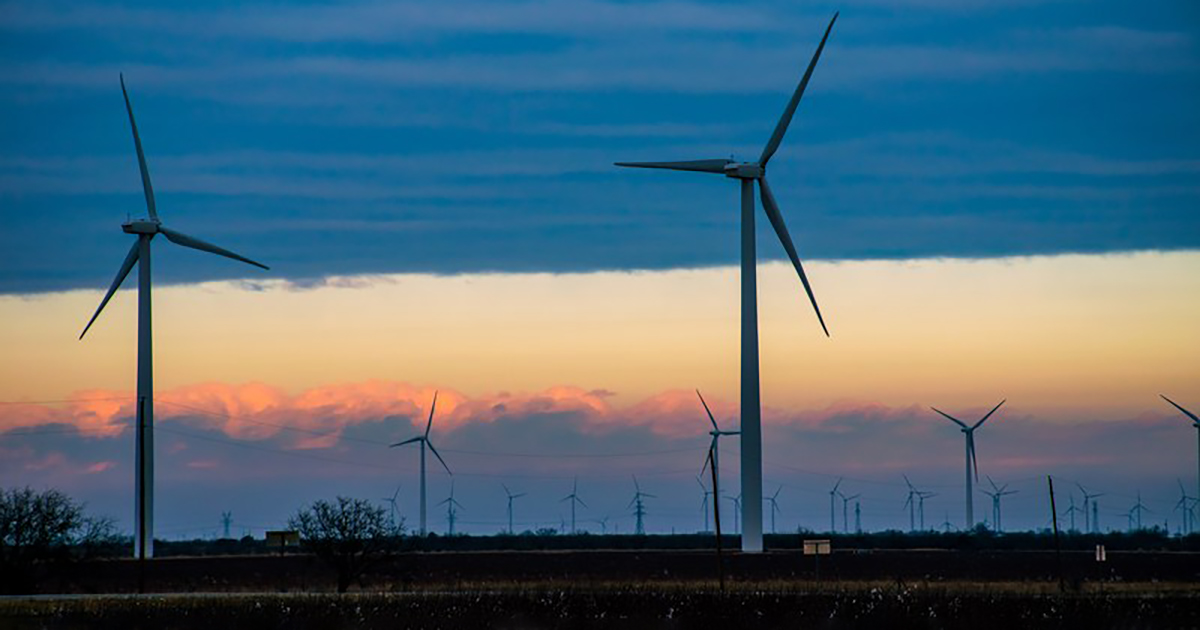The Texas wind farm fleet is continuing to grow, but its effect on power prices depends on where the wind farms are located.
Generally, Texas wind farms have dampened wholesale power prices, but they’ve also increased price volatility and can have an outsized impact on summer-time prices.
Generally, Texas wind farms have dampened wholesale power prices, but they’ve also increased price volatility and can have an outsized impact on summer-time prices.
how the
Texas Wind Fleet Grows, and Keeps Growing
The Electric Reliability Council of Texas (ERCOT), which operates the grid for most of the state, has about 23,865 MW of wind power, up from 100 MW two decades ago. The state ranks number one in installed wind capacity among U.S. states, and only four countries have more wind generation capacity.
The grid operator divides Texas wind into three areas: coastal, Panhandle, and “other,” which is mainly in West Texas. There’s 3,290 MW in the coastal area, 4,410 MW in the Panhandle, and 16,165 MW in the rest of the state.
ERCOT expects the state’s wind fleet to grow by about 3,980 MW based on executed interconnection agreements, with 740 MW slated to be added in the coastal area and 3,240 MW in the rest of the state.
The state’s 154 wind farms recently set key records. At one point on January 8, 2020, the fleet produced 20,066 MW, supplying 52.8 percent of the state’s electricity, according to ERCOT. On May 2, 2020, the wind farms set a record by supplying 59.3 percent of the electricity demand in Texas.
Generally, wind farms reduce wholesale power prices by displacing more expensive natural gas-fired generation.
The grid operator divides Texas wind into three areas: coastal, Panhandle, and “other,” which is mainly in West Texas. There’s 3,290 MW in the coastal area, 4,410 MW in the Panhandle, and 16,165 MW in the rest of the state.
ERCOT expects the state’s wind fleet to grow by about 3,980 MW based on executed interconnection agreements, with 740 MW slated to be added in the coastal area and 3,240 MW in the rest of the state.
The state’s 154 wind farms recently set key records. At one point on January 8, 2020, the fleet produced 20,066 MW, supplying 52.8 percent of the state’s electricity, according to ERCOT. On May 2, 2020, the wind farms set a record by supplying 59.3 percent of the electricity demand in Texas.
Generally, wind farms reduce wholesale power prices by displacing more expensive natural gas-fired generation.
why
Not All Texas Wind is Created Equal
In a crucial way, the wind farms in the three areas are different in that they have different capacity factors, a measure of how much electricity they can produce on average compared to their capacity rating.
The U.S. wind fleet, for example, had an average capacity factor of 34.8 percent last year, up from 29.7 percent in 2010, according to the Energy Information Administration. However, capacity factors vary by location and by season.
In Texas, coastal wind farms as a group have a 63 percent capacity factor during summer peak hours, followed by a 29 percent capacity factor for the Panhandle and 16 percent for the rest of the wind farm fleet, according to ERCOT. Those numbers reflect the generally strong coastal winds in the afternoon in the summer and the weak West Texas winds during peak summer hours.
Based on those capacity factors, ERCOT expects wind farms to contribute about 5,945 MW on average during peak periods this summer, with coastal wind farms adding 2,075 MW, Panhandle wind adding 1,280 MW, and the rest of the state adding 2,590 MW.
Transmission constraints are another issue affecting the ability of West Texas wind to reach major load centers. The Competitive Renewable Energy Zone transmission buildout was designed to support 14,000 MW of renewables in West Texas, but there is currently about 13,335 MW of wind and 4,250 MW of solar in the region. ERCOT expects about 25,000 MW of wind and solar to be connected to the grid in West Texas next year.
The U.S. wind fleet, for example, had an average capacity factor of 34.8 percent last year, up from 29.7 percent in 2010, according to the Energy Information Administration. However, capacity factors vary by location and by season.
In Texas, coastal wind farms as a group have a 63 percent capacity factor during summer peak hours, followed by a 29 percent capacity factor for the Panhandle and 16 percent for the rest of the wind farm fleet, according to ERCOT. Those numbers reflect the generally strong coastal winds in the afternoon in the summer and the weak West Texas winds during peak summer hours.
Based on those capacity factors, ERCOT expects wind farms to contribute about 5,945 MW on average during peak periods this summer, with coastal wind farms adding 2,075 MW, Panhandle wind adding 1,280 MW, and the rest of the state adding 2,590 MW.
Transmission constraints are another issue affecting the ability of West Texas wind to reach major load centers. The Competitive Renewable Energy Zone transmission buildout was designed to support 14,000 MW of renewables in West Texas, but there is currently about 13,335 MW of wind and 4,250 MW of solar in the region. ERCOT expects about 25,000 MW of wind and solar to be connected to the grid in West Texas next year.
understanding
Wind's Impact on Summer Prices
Typically, wind farms produce the most electricity in the evening and the least in the afternoon. This pattern can have a big effect on wholesale prices, especially in the summer when ERCOT’s reserves can be low and the grid operator’s “operating reserve demand curve” mechanism kicks in to boost prices. When system reserves are low, relatively small changes in wind farm output can have a big effect on real-time prices.
Two days last summer show the variability in wind output and the effect it can have on pricing. On July 20, wind farms met nearly 40 percent of ERCOT’s load early in the morning and about 20 percent of the load in the afternoon. Wind capacity factors in the afternoon were in the 55 percent range and wholesale prices were in the $20/MWh range with peak demand relatively modest at 67,740 MW.
Then on August 13, amid a heat wave and demand climbing to 74,180 MW, wind farms were supplying only 5 percent of ERCOT’s load in the afternoon, with capacity factors in the 15 percent range. Real-time prices hit the $9,000/MWh cap and averaged $2,500/MWh in the afternoon.
While wind will clearly affect power prices this summer, it’s unclear how the new coronavirus pandemic will factor into the pricing equation.
For the week starting April 19 when the state’s stay-at-home order was in full effect, peak demand and energy use was down by about 5 percent, according to ERCOT. Morning loads were up to 10 percent below normal. However, when the hot weather hits, it’s possible residential air conditioning load will offset a drop in commercial and industrial load.
As usual, we’ll be watching the power market for changes and looking for ERCOT’s upcoming summer assessment report, which should offer more clues to the summer outlook.
Two days last summer show the variability in wind output and the effect it can have on pricing. On July 20, wind farms met nearly 40 percent of ERCOT’s load early in the morning and about 20 percent of the load in the afternoon. Wind capacity factors in the afternoon were in the 55 percent range and wholesale prices were in the $20/MWh range with peak demand relatively modest at 67,740 MW.
Then on August 13, amid a heat wave and demand climbing to 74,180 MW, wind farms were supplying only 5 percent of ERCOT’s load in the afternoon, with capacity factors in the 15 percent range. Real-time prices hit the $9,000/MWh cap and averaged $2,500/MWh in the afternoon.
While wind will clearly affect power prices this summer, it’s unclear how the new coronavirus pandemic will factor into the pricing equation.
For the week starting April 19 when the state’s stay-at-home order was in full effect, peak demand and energy use was down by about 5 percent, according to ERCOT. Morning loads were up to 10 percent below normal. However, when the hot weather hits, it’s possible residential air conditioning load will offset a drop in commercial and industrial load.
As usual, we’ll be watching the power market for changes and looking for ERCOT’s upcoming summer assessment report, which should offer more clues to the summer outlook.





